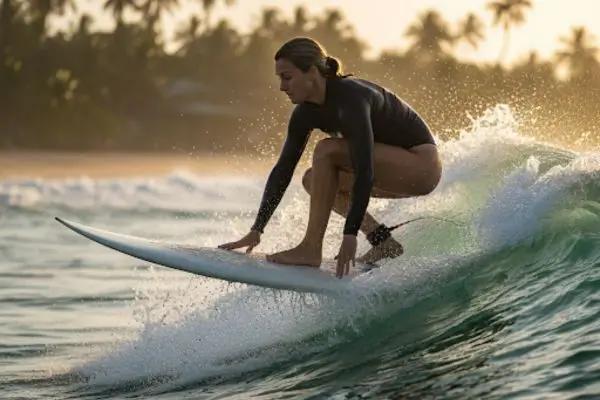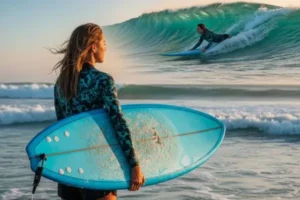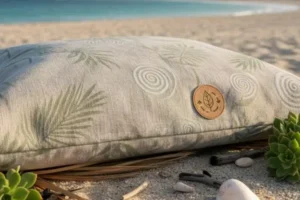In surfing, catching the right wave is as much about positioning as it is about paddling or standing up. For women surfers, learning how to place themselves correctly in the lineup and on the wave itself can unlock consistency, confidence, and longer rides. Wave positioning is the art of being in the right place at the right time, and mastering it is one of the most valuable skills any surfer can develop.
This article explores the fundamentals of positioning, mistakes to avoid, and practical steps for women surfers who want to improve their awareness and decision-making in the ocean.
Why Wave Positioning Matters
Even with great paddling and pop up skills, poor positioning can mean missed waves or wipeouts. On the other hand, good positioning offers:
- Better Wave Count: Sitting in the right spot means catching more waves during a session.
- Energy Efficiency: Smart positioning reduces wasted paddling and conserves energy.
- Longer Rides: Taking off from the right point allows for smoother, more extended rides.
- Confidence in Crowds: Knowing where to be helps women surfers feel secure, even in busy lineups.
Understanding the Lineup
The lineup is the area where surfers wait for incoming waves. Positioning here is influenced by wave shape, crowd dynamics, and individual goals.
Key Elements:
- Peak: The part of the wave where it first begins to break — usually the most powerful spot.
- Shoulder: The unbroken section of the wave, which offers easier entry but less power.
- Impact Zone: Where waves crash hardest; not ideal for waiting, but important for understanding timing.
Women surfers who can identify these elements quickly will know where to sit and when to paddle.
Step-by-Step: Improving Positioning
Step 1: Study the Break Before Entering
Spend five to ten minutes observing the waves from the beach. Notice where most waves begin to peel, where surfers are catching them, and how often sets arrive.
Step 2: Start Slightly Further Out
For beginners, it’s often safer to sit a little further outside (away from the breaking waves) until comfort builds. From there, slowly inch closer to the peak.
Step 3: Watch Other Surfers
Observe experienced surfers. Their positioning often reveals the best takeoff spots. Pay attention to their paddling angles and where they sit in relation to the wave.
Step 4: Adjust Constantly
The ocean is never static. Shift position every few minutes as sets roll in. Micro-adjustments make a big difference in wave count.
Step 5: Angle the Takeoff
Instead of always paddling straight toward the beach, practice angling slightly left or right depending on the wave’s direction. This improves positioning and ride quality.
Common Mistakes in Positioning
- Sitting Too Far Inside: Leads to waves breaking directly on top of you.
- Being Too Far Outside: Results in missed waves because you’re not close enough to the peak.
- Ignoring Set Waves: Focusing only on small waves while missing the bigger, better ones behind.
- Not Reading the Shoulder: Paddling into a wave that closes out instead of following its peeling side.
Tools to Help with Positioning
- Landmarks: Use points onshore (trees, rocks, lifeguard towers) to keep track of your position in the lineup.
- Wave Counting: Notice patterns in sets. For example, if every fifth wave is bigger, prepare earlier.
- Surf Etiquette: Respect priority rules. Even perfect positioning won’t help if you’re dropping in on another surfer.
Drills to Practice Positioning
- Shadow a Surfer: Choose a skilled surfer in the lineup and mimic their positioning without interfering.
- One-Wave Focus: Instead of chasing every ripple, commit to reading and positioning for just one wave.
- Angle Pop Ups on Land: Practice standing on a surfboard simulator or mat while facing slightly left or right.
Positioning in Different Conditions
Small Waves
Sit closer to the peak, as smaller waves have less push and require earlier commitment.
Larger Waves
Position slightly further outside to catch the wave earlier and avoid being caught in the impact zone.
Crowded Lineups
Be patient and observant. Look for secondary peaks or shoulders that others may overlook.
Building Confidence with Positioning
For many women surfers, positioning feels intimidating at first — especially in busy spots. Confidence comes with practice and observation. By combining patience with smart adjustments, the lineup becomes less overwhelming and more empowering.
Wave positioning is not just about physics; it’s about presence. The ability to sit calmly, read the ocean, and move with precision transforms a session from frustrating to fulfilling.
Riding Waves with Awareness
Wave positioning is the silent skill that often separates beginners from confident surfers. It takes observation, adaptability, and patience, but it rewards with more waves, longer rides, and deeper connection to the ocean.
Every surf session offers a chance to refine positioning, even on days with small or messy waves. By learning to sit in the right place, women surfers step into the rhythm of the sea — where confidence builds, rides extend, and the ocean feels like home.




